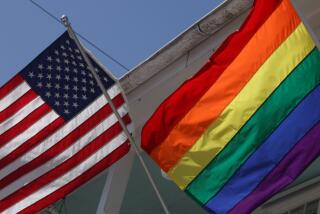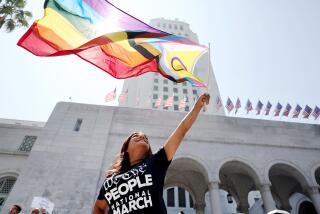The Times Poll : AIDS Threat Changes Life Style of 1 in 5
- Share via
Nearly one in five Americans say they have made major changes in their life style because of the threat of AIDS, a Los Angeles Times Poll has found.
The percentage of respondents who say AIDS has caused an “almost total” or “large” change in their life style has tripled--from 6% to 18%--in the 19 months since the last Times Poll on AIDS.
Moreover, the reported changes in life style were more often reported by those who said they had had multiple sexual partners within the last year and by respondents aged 18 to 24, groups often identified by health officials as being at greater risk of contracting the disease. For example, about half the respondents with multiple recent sexual partners said they had bought condoms at least once within the last year.
While an overwhelming majority of Americans continue to rate their personal risk of contracting the fatal AIDS virus as very low, the nationwide survey showed a higher degree of knowledge, contact and concern over AIDS, in many cases far higher than when the previous poll was taken in December, 1985.
More than one in 10 Americans surveyed said they have personally known someone who has tested positive for the AIDS virus, contracted AIDS or died of the disease. The figure was 15% in Los Angeles and 25% in the metropolitan San Francisco area. For purposes of the poll, “knowing someone” was defined as “someone you would speak with at least once a month.”
The survey also showed a substantial increase--from 35% to 52%--in the number of respondents who said they were knowledgeable about the deadly disease.
In addition, since the last poll, the percentage of Americans who rank AIDS as the disease they are most afraid of getting has more than doubled, from 12% to 30%. Cancer remains the most feared disease nationwide, but since the December, 1985, poll, the percentage of respondents who identified cancer as most feared declined from 56% to 40%.
Moreover, AIDS now surpasses cancer as the most feared disease in the Los Angeles, San Francisco and New York City metropolitan areas, which account for about 45% of all AIDS cases in the United States, and among adults nationwide between the ages of 18 and 30.
“Everywhere you look you can see that concern is mounting,” said I. A. Lewis, director of the Times Poll. “Educational efforts are having a double effect. One is that more people are aware of the correct facts about the disease. The other is that better education has been scaring people and they are getting more anxious.”
But despite a barrage of AIDS publicity throughout the United States, 46% of respondents rated their knowledge of the disease as “not very much” or “hardly anything,” including 40% of respondents ages 18 to 24 and 38% of respondents who said they had had multiple sexual partners in the last year. A key theme of AIDS educational programs has been the risks, particularly for young adults, of contracting AIDS through promiscuous sexual behavior.
The telephone poll of 2,095 people, conducted July 24 to 28, was designed to assess AIDS-related attitudes and behaviors and to see how knowledge, risk and fear of the disease had changed since the 1985 Times Poll. Further, by interviewing additional individuals in areas where AIDS is most common, the survey allowed comparisons of the disease’s impact in Los Angeles, San Francisco and New York City.
As of Monday, 39,263 AIDS cases and 22,548 AIDS deaths had been reported nationally, according to the federal Centers for Disease Control. At the time of the earlier survey, there had been 15,581 AIDS cases and 8,002 AIDS deaths.
The vast majority of AIDS cases have developed in homosexual or bisexual men and in intravenous drug users; about 4% have occurred after heterosexual exposure to the virus that causes the deadly disease.
Perhaps the most dramatic indicator in the poll of heightened personal AIDS concerns was the substantial increase in the percentage of adults who said the disease was having an “almost total” or “large impact” on their life style. Included in this group were 28% of the respondents who said they had had multiple sexual partners in the last year, 24% of all respondents ages 18 to 24, and 33% of respondents from the New York City area.
However, two-thirds of those polled said that they had made “almost no change” in life style due to AIDS, and 18% said there had been only a small impact on their lives.
When asked to rate “your own personal risk of contracting AIDS,” 84% of those interviewed continued to classify their personal risk as very low, compared to 85% of those interviewed in the earlier survey. But asked “how concerned are you about AIDS as a problem for your own personal health?” nearly half rated themselves as “very concerned” or “fairly concerned.”
Those who said they feared contracting AIDS the most included blacks and single men and women under age 30. In general, people over 45 had the least degree of anxiety about the disease.
This perception of personal risk also varied with the number of sexual partners that respondents said they had had in the last year. Of the 70% who said they had one sexual partner and the additional 15% who said they were celibate, 86% placed themselves in the very low risk category.
But of the 11% of respondents who said they had had multiple sexual partners, 65% placed themselves in the very low risk group and 23% said their risk was medium or higher.
Despite recognition that monogamy and celibacy are useful AIDS precautions, many of those with multiple sexual partners did not always follow their own advice.
Fewer Partners
When asked what “have you found to be the most practical precaution against AIDS,” 37% of those with several recent partners answered having sex with only one partner and 7% favored refraining from sex.
An additional 32% said it was so-called “safe sex” precautions, such as the use of condoms, which many researchers believe reduce the chances of sexual transmission of the virus. But of those favoring “safe sex” precautions, only 58% said they had in fact purchased a package of condoms within the last year.
An additional 11% favored cutting down on their number of partners and and 4% favored questioning their partners more closely about their pasts.
Comparisons between the two polls also provided evidence that AIDS educational efforts appear to be having some effect.
The percentage of those interviewed who said they would “make friends” with someone who tested positive for AIDS antibodies increased to 42% from 35%. The percentage who said they would avoid such a person “as a health precaution” decreased from 47% to 41%. There is no evidence that the AIDS virus can be transmitted by casual contact.
Other misconceptions about the spread of the disease were also less frequent--20% said people could catch AIDS from a toilet seat, compared to 24% in the earlier survey. And 14% said people could catch AIDS from eating food that had been handled by an infected individual, compared to 19% of the respondents to the earlier survey.
In a related finding, 87% of those interviewed this month said they could “adequately protect themselves against AIDS” by their own behavior, compared to 79% of the respondents in the earlier survey. Public health officials have emphasized that people must take primary responsibility for protecting themselves against the disease, now that the threat of exposure to the AIDS virus through contaminated blood transfusions has virtually been eliminated.
Another striking finding was a sharp turnaround on the question of whether “the current hysteria over AIDS is largely a creation of the media.” In December, 1985, 60% of respondents agreed that media hysteria was to blame, while 34% disagreed. But this month, the percentages reversed, with 34% of respondents blaming media hysteria and 57% rejecting it as a significant factor. About 70% said the media did not exaggerate the health risks involved with AIDS.
There was also more pessimism about when researchers were likely to find a cure for AIDS. The percentage who said within six years declined from 41% to 29%, while the percentage who said “never” increased from 15% to 19%.
AIDS, or acquired immune deficiency syndrome, is caused by a virus that attacks the body’s immune system, leaving the victim vulnerable to a variety of infections and tumors. The virus is transmitted by sexual contact, through exposure to contaminated blood and from an infected mother to her newborn.
The sampling error of the poll was plus or minus 3%. This means that the results could vary by three percentage points in either direction.
AIDS CASES IN THE U.S.
These are AIDS cases as reported by the Centers for Disease Control for Standard Metropolitan Statistical Areas:
Total U.S. Los Angeles San Fran. New York Through July, 1987 39,263 3,400 3,858 10,229 Through Dec., 1985 15,581 1,308 1,721 5,012 AIDS CASES PER MILLION Through July, 1987 164 425 1,102 1,112 Through Dec., 1985 68 175 530 529
ATTITUDES ABOUT AIDS
These are results of a Los Angeles Times Poll of 2,095 residents nationwide between July 24 and July 28. Percentage who said AIDS had an almost total or large impact on their life style:
July 1987 responses: National: 18% Los Angeles: 20% San Francisco: 29% New York City: 33%
December 1985 responses: National: 6% Los Angeles: 12% San Francisco: 5% New York City: 12% Percentage concerned about AIDS as a problem for their personal health
July, 1987 Dec., 1985 National 46% 42% Los Angeles 49% 49% San Francisco 44% 33 % New York City 57% 56%
Percentage who know someone who has tested positive for the AIDS virus, developed AIDS or died of AIDS
July, 1987 Dec., 1985 National 11% 5% Los Angeles 15% 14% San Francisco 25% 15 % New York City 20% 16%
Percentage who felt knowledgeable about AIDS
July, 1987 Dec., 1985 National 52% 35% Los Angeles 60% 43% San Francisco 63% 56% New York City 50% 43%
Percentage who would befriend a person who tested positive for AIDS antibodies
July, 1987 Dec., 1985 National 42% 35% Los Angeles 53% 35% San Francisco 54% 43% New York City 36% 37%
More to Read
Sign up for Essential California
The most important California stories and recommendations in your inbox every morning.
You may occasionally receive promotional content from the Los Angeles Times.










